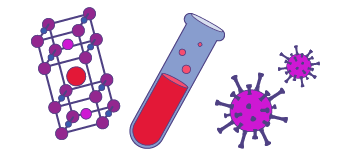The physics of cyclotron resonance (CR) and angle-dependent magneto-resistance oscillations (AMRO - See DC Transport) in low-dimensional metals is the same
The physics of cyclotron resonance (CR) and angle-dependent magneto-resistance oscillations (AMRO - See DC Transport) in low-dimensional metals is the same [1]. Application of a magnetic field gives rise to a Lorentz force that drives quasiparticles (correlated electrons) across the Fermi surface (FS) at a constant rate of change of momentum, resulting in periodic oscillations of their velocities as they traverse the warped FS. The resulting ‘cyclotron’ frequency, ωc, may be related directly to the underlying band structure and, in particular, to the effective mass, m*, or the Fermi velocity, vF. In fact, the motion need not be cyclical—merely periodic. Hence, this effect is sometimes termed periodic orbit resonance (POR [2]). In the Boltzmann picture, an oscillatory velocity leads to a modification of the Drude conductivity formula, i.e., σ(ω,B) = σo[1 + i(ω − ωc)τ]−1, where τ is the transport scattering time and σo is the zero-field DC conductivity. The key point is that ω and ωc play identical roles, hence the correspondence between AMRO, POR and the Drude optical conductivity [1]. Thus, it becomes clear that narrow-band POR measurements performed at fixed microwave frequency, (ω, whilst sweeping the ‘cyclotron’ frequency, (ωc (i.e., the field), may be compared directly with zero-field (ωc = 0) broadband optical studies in which (ω is swept. An example of such a measurement is displayed in the figure above. This technique may be applied to a vast array of low-dimensional conductors, provided they are reasonably clean, i.e., ωc τ > 1.
The CR/POR technique is extremely powerful. For example, angle-dependent studies provide extremely precise information concerning FS topology [3-6]. In fact, the POR harmonic content is directly related to the Fourier spectrum of the FS warping (through tight-binding matrix elements) [1]. Knowledge of this harmonic content is crucial for understanding FS instabilities, which ultimately may be responsible for the pairing that gives rise to the superconductivity in many low-dimensional metals. Angle-dependent studies also provide momentum-resolved measurements of m* and τ [4]. In this way, one may study if and how correlations develop locally on the FS. We note also that m* and τ are obtained completely independently: m* (= eB/ω) from the resonance field, and τ from the resonance linewidth [7].

Explore our magnet schedule to see what exciting research is happening on our stellar fleet of instruments right now.
S. Hill and S. Takahashi, Microwave spectroscopy of Q1D and Q2D organic conductors, in The Physics of Organic Superconductors and Conductors, Berlin Heidelberg. Ed. Andrei Lebed (2008) Read online.
S. Takahashi, et al, Study of Non-Magnetic Impurity Effects of the Organic Superconductor (TMTSF)2ClO4, Proc. 24th Int. Conf. on Low Temperature Physics, AIP conference proceedings, Volume 850 (2006) Read online.
S. Takahashi, et al, Cyclotron resonance in the quasi-1D organic superconductor (TMTSF)2ClO4, Phys. Rev. B 72 (2005) Read online.
A. E. Kovalev, et al, Determination of the Fermi Velocity by Angle-dependent Periodic Orbit Resonance Measurements in the Organic Conductor α-(BEDT-TTF)2KHg(SCN)4, Phys. Rev. B 66 (2002) Read online.
A. E. Kovalev, et al, Angle-resolved mapping of the Fermi velocity in a quasi-2D organic conductor, Phys. Rev. Lett. 91 (2003) Read online.
S. Hill, et al, Cyclotron Resonance in the Layered Perovskite Superconductor Sr2RuO4, Phys. Rev. Lett. 84 (2000) Read online.
Stephen Hill, et al, A semiclassical description of cyclotron resonance in quasi two-dimensional conductors: theory and experiment, Phys. Rev. B 55 (1997) Read online.
Last modified on 22 August 2023